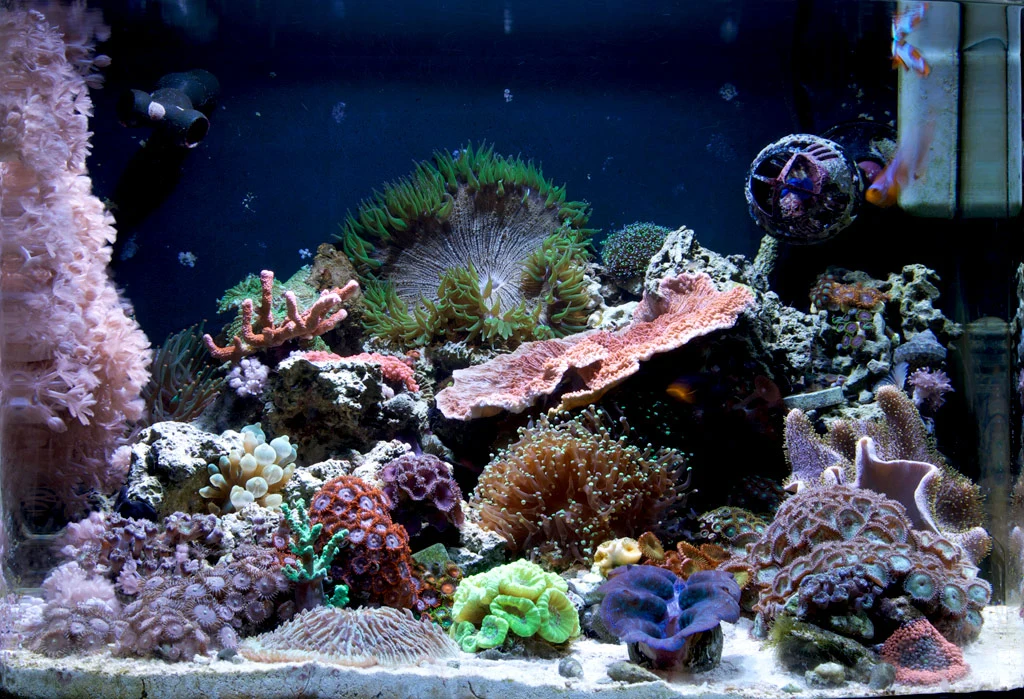Stunning 29-Gallon Reef Tank – HeyLookItsCaps's TOTM | NanoReef

Tank Specifications
Volume: 29 Gallons / 109 Liters
Dimensions (L × W × H):
20.8" ×
19.0" ×
20.1"
52.9cm ×
48.3cm ×
50.8cm
Equipment List
No equipment information available
Frequently Asked Questions
How often should I perform water changes in my reef tank?
Frequent water changes are crucial for maintaining tank health. In my routine, I change 5 gallons of water every week, which has been key to my success. You can adjust this frequency based on your tank's bioload and water quality.
What should I feed my reef tank inhabitants?
I feed my fish bi-weekly on Tuesdays and Saturdays. On Tuesdays, I provide a mix of Mysis shrimp, Brine shrimp, and Cyclopeeze, while on Saturdays, I feed them pellets and algae wafers. Adjust your feeding schedule based on the tank's needs and observe if leftover food is accumulating.
How do I maintain cleanliness in my reef tank?
I frequently scrape the glass using a scraper, toothbrush, or brillo pad to prevent algae buildup. I also keep an eye on sand cleanliness, thanks to the snails and starfish in my tank.
How should I manage my auto-top-off (ATO) system?
It's a good practice to fill the ATO reservoir every 4 days, checking regularly to ensure your system is functioning correctly and providing adequate evaporation replacement.
What dosing regimen should I follow for calcium in a nano reef aquarium?
I've recently started dosing small amounts of calcium, as it may be necessary based on your coral growth. Frequent water changes generally provide sufficient trace elements for most nano reef tanks. Monitor your levels regularly.
What type of lighting is best for a reef tank?
For my tank, I use a CurrentUSA 150w Sunpod with a Radium 20k bulb, which provides excellent growth and a beautiful shimmer that mimics natural environments. While T5 lighting is efficient, I prefer Metal Halide due to the aesthetic benefits.
Is a protein skimmer necessary for my reef tank?
While I initially used a CPR skimmer, I found it wasn't pulling out significant waste and was quite loud. After removing it, I noticed no ill effects and now rely on natural filtration and frequent water changes instead.
How do I effectively manage circulation in my reef tank?
I use an MJ1200 return pump, coupled with a modified Koralia 1 for increased flow. This has greatly benefited coral health and overall tank stability. Ensure your circulation setup matches your specific coral needs and tank layout.
What kind of filtration system works for a nano reef tank?
My setup includes live rock and filter floss, which have been effective for mechanical biofiltration. A good filter pad at the waterline helps skim debris and support water quality.
How can I maintain an appropriate sandbed in my reef tank?
I maintain a moderate sandbed of about 2-3 inches for both aesthetics and habitat for beneficial organisms. It's essential to keep it clean to avoid detritus buildup; my clean-up crew helps with this task.
What should I consider when adding new corals to my tank?
Research your desired corals well, considering their compatibility and potential space needs. Corals can have aggressive behavior toward one another, and I highly recommend avoiding overcrowding the tank to reduce competition for space and resources.
How can I prevent coral stinging in my aquarium?
To minimize the risk of coral stinging, be cautious with the selection and placement of corals. Some species can be aggressive, so providing adequate distance between them and managing their growth is essential.
How can I effectively manage feeding in a reef tank?
I've learned that feeding every other day can lead to uneaten food settling on the sandbed. I now feed twice a week and monitor the aquarium after feeding to ensure food is consumed quickly. Adjust as needed based on the response from your tank inhabitants.
What is a good clean-up crew composition for a nano reef tank?
A good clean-up crew (CUC) includes small hermits, various snails, and potentially some starfish. They will help manage waste and algae, but balance is key to prevent larger snails or crabs from disturbing corals.
How can I tell if my tank inhabitants are stressed or unhealthy?
Watch for signs such as unusual behavior, loss of appetite, or visible health issues like swelling or discoloration. Regular observation and water quality checks can help identify issues before they escalate.